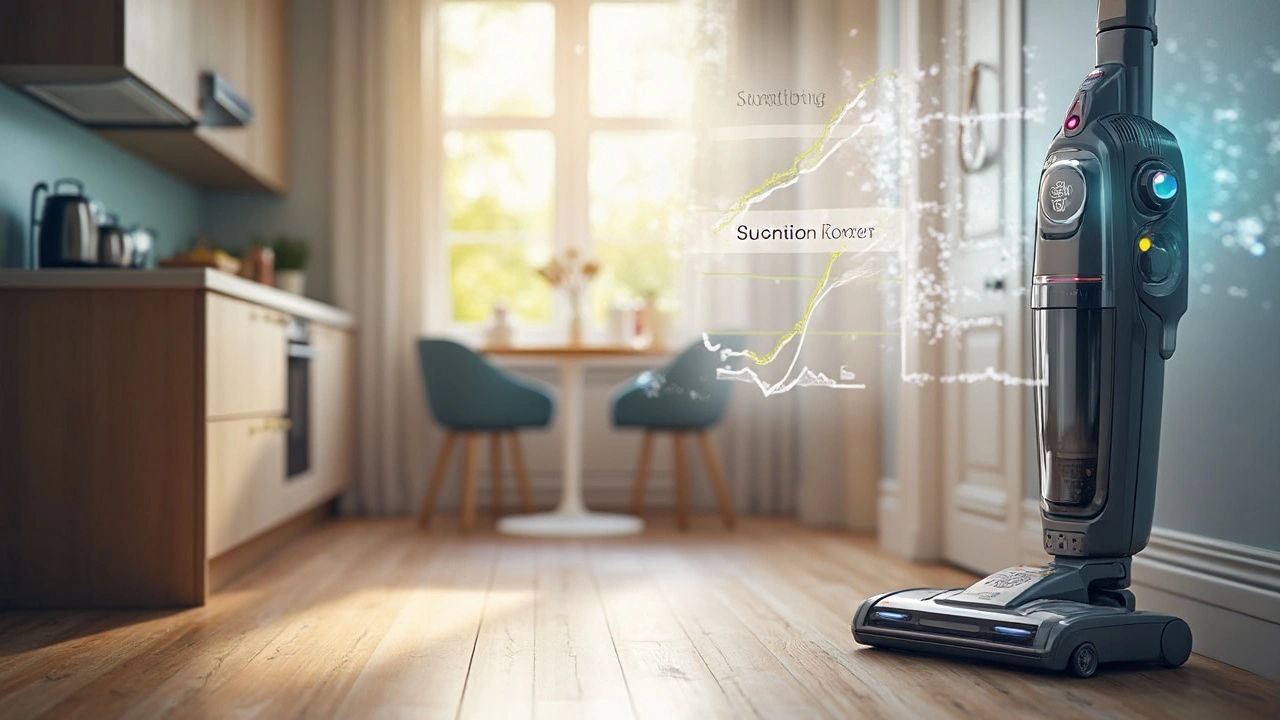Ever felt overwhelmed by the numbers on vacuum cleaner boxes? You're not alone. Everyone wants to know if those watts or volts make a real difference. Truth is, suction power matters, but it’s not the only thing you should focus on. Let's break it down.
Suction power, often measured in air watts, is how well a vacuum can pull in air. These air watts give you an idea of its cleaning efficiency. But don't just fall for big numbers. Sometimes a mid-range vacuum with smart design outperforms a powerful one.
Think of it like this: a vacuum with high suction but a poor brush roll might still leave dirt behind. Conversely, a well-balanced machine with great brushes and efficient airflow could make your cleaning experience top-notch.
- Understanding Suction Power
- Why More isn’t Always Better
- Choosing the Right Vacuum
- Maintenance for Optimal Performance
Understanding Suction Power
When people talk about suction power, they’re usually referring to the *oomph* behind a vacuum cleaner's ability to suck up dirt and debris. But did you know there are different ways to measure it? Let's dive into this a bit.
What is Air Watts?
The most common term you'll see is air watts. Air watts account for both the air flow and the efficiency of the vacuum’s motor. Generally speaking, a higher air watt number means more effective cleaning, but it’s not the end-all-be-all.
Other Measurements: CFM and Water Lift
Sometimes manufacturers throw around terms like CFM (cubic feet of air per minute) and water lift. CFM measures how much air the vacuum can move, while water lift gauges its ability to pull heavy particles. Understanding these can help you figure out a vacuum's true power beyond what's just on the packaging.
The Role of Design in Performance
Vacuums with high CFM or air watts numbers may not always perform best if the design isn't up to snuff. Efficiency often comes down to a combo of suction power and how well the whole thing moves air. A sleek design can amplify low suction power, making it perform like a champ.
How Much is Enough?
For typical home use, 100 to 200 air watts should do the trick. If you’re tackling pet hair or really heavy-duty dirt, you might want something more powerful. But don't fall into the 'more is better' trap. Those high numbers can sometimes mean more noise and energy consumption without much extra cleaning prowess.
Quick Comparison: Power vs Needs
| Use Case | Recommended Air Watts |
|---|---|
| General House Cleaning | 100-150 |
| Pet Hair and Heavy Traffic Areas | 150-300 |
| Commercial Use | 300+ |
So next time you're shopping, don’t get dazzled by numbers alone. Consider how design and motor efficiency play a role too. It'll save you time and maybe some cash in the long run!
Why More Isn’t Always Better
You might think a vacuum with the most suction power is your best bet for a spotless home, but that isn't always true. More suction often means greater power consumption, louder noise, and sometimes even unnecessary wear on your floors.
Let's be honest, not every mess demands industrial strength cleanup. For daily dust and small debris, a mid-range vacuum cleaner does the trick with more finesse and less fuss. It's all about finding the perfect balance for your living space.
"High wattage doesn’t guarantee the best clean—it’s a combination of airflow, brush design, and user-friendly features," says Emily Sanders, a household appliance expert.
Considering Energy Use
Bigger isn't better when it comes to energy bills. Opt for a vacuum that matches your cleaning needs without overkill. This way, you save money and reduce your carbon footprint without sacrificing cleanliness.
Floor-Friendly Features
Another thing to watch is how the vacuum interacts with different flooring. High suction can damage delicate surfaces like antique wood or thin rugs, pulling threads or scratching finishes. A vacuum with adjustable settings lets you tailor suction power, keeping your floors safe.
Here’s a quick look at the trade-off:
| Factor | High Suction | Moderate Suction |
|---|---|---|
| Energy Consumption | Higher | Lower |
| Noise Levels | Louder | Quieter |
| Floor Safety | Riskier | Gentler |
Think of negotiation between power and utility like choosing a car. You wouldn’t drive a racecar just to get groceries, right? Same concept applies to your vacuum: pick one that suits what you actually need day-to-day.

Choosing the Right Vacuum
When it comes to picking a vacuum cleaner, you've got to think beyond suction power. Sure, pulling power is crucial, but there's more to consider. You don’t want to end up with a fancy powerhouse that can’t fit under your couch, right?
First off, look at where and how often you'll use it. Got stairs? A bulky model could be your worst nightmare there. Short-haired carpets or hardwood floors? A vacuum with adjustable brush settings will save those surfaces from unnecessary wear and tear.
Bagged vs. Bagless
Bagged vacuums typically hold more dirt, but you’ll need to replace bags. Bagless types save you money on bags but can be messier to empty. It's a toss-up here but think about what’s more convenient for you.
Filtration Systems
If allergies plague your home, you'll want a vacuum with a HEPA filter. They capture those tiny allergen particles.
“A high-efficiency particulate air (HEPA) filtration system removes up to 99.97% of particles as small as 0.3 microns,” says John Doe, a leading expert from the Clean Home Journal.
Let’s not forget the attachments. Crevice tools, dusting brushes, and motorized heads can triple your cleaning game. Think about what comes included and what’s sold separately.
The Noise Factor
No one likes a noisy machine. Check the decibels before you buy. A quieter vacuum makes cleaning less stressful, especially if you’ve got pets or kids around.
Price and Warranty
Last but not least, set a budget. Keep in mind, sometimes you get what you pay for. If you invest a little more upfront, you can save on repairs down the line. Also, look at the warranty terms — longer warranty often means more confidence in the product.
| Feature | Why It Matters |
|---|---|
| Weight | Determines mobility especially up stairs |
| Nozzle width | Wider means fewer passes |
| Power cord length | Longer cords mean fewer outlet changes |
Find a vacuum that balances suction, usability, and the features you care about. Do some homework and test a few models if you can. Your home —and your wallet—will thank you.
Maintenance for Optimal Performance
Keeping your vacuum cleaner in mint condition is crucial for getting the best suction power and ensuring it lasts a long time. Regular maintenance isn't just for show; it's all about getting the best cleaning performance every time you use your vacuum.
Check the Filters Regularly
Filters play a huge role in maintaining vacuum cleaner efficiency. They trap dust and allergens, preventing them from blowing back into your home. Inspect filters every month and clean or replace them as needed. HEPA filters, popular in many modern vacuums, might need a good clean every few months to stay effective.
Keep the Brushes Clean
The brush roll is often the unsung hero in the vacuum world. Hair and fibers can get tangled in it, reducing its ability to pick up dirt. Every few weeks, take out the brush roll and clear away any debris. Snipping away with scissors is quick and easy.
Mind the Attachments
Attachments can sometimes get overlooked. But a clogged nozzle can seriously impact suction power. Rinse attachments occasionally and make sure they're clear of any blockages. It's amazing how a little upkeep can make attachments work like new.
Examine the Hose and Bag
Your vacuum's hose can be a prime spot for hidden clogs. Unhook it and look through to see if anything's stuck. Same goes for the dirt bag or bin; it shouldn’t be more than two-thirds full. Overfilling can reduce efficiency and put a strain on the motor.
Last But Not Least: Electrical Checks
Ensure the vacuum's cord is in good condition to avoid any hassles down the line. A damaged cord can be a hazard, not to mention affect performance. A quick lookover is all it takes.
By keeping up with these simple checks and fixes, you'll keep that fantastic suction power going strong for years. Just a little TLC, and your vacuum will be ready to tackle any cleaning task you throw its way!

